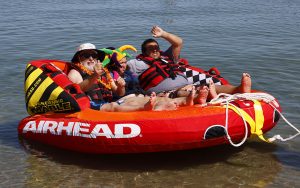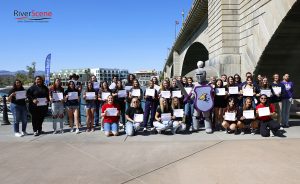PART 2
What Citizens Can Do In An Emergency
The Lake Havasu City Preparedness Guide offers tips on helping in an emergency. If residents happen upon a person who needs help, first check the scene to be sure it’s safe to help; if it isn’t, stay out of the hazard zone. Call 911 or the local emergency number, then check the victim for breathing, pulse and bleeding. Give 911 location and the victim’s condition. Don’t move anyone who is injured unless the person is in danger. Don’t hang up until the dispatcher says you can. Help the person rest comfortably and keep him/her warm or cool as needed and offer reassurance.
Create a Disaster Plan. One of the most important steps a person can take in preparing for emergencies is to develop a household disaster plan.
1. Learn about the natural disasters that could occur in the community from the fire department, county emergency management office or American Red Cross chapter. Learn whether hazardous materials are produced, stored or transported near your area. Learn about possible consequences of deliberate acts of terror. Ask how to prepare for each potential emergency and how to respond.
2. Talk with employers and school officials about their emergency response plans.
3. Talk with your household about potential emergencies and how to respond to each. Talk about what would need to be done in an evacuation.
4. Plan how your household would stay in contact if separated. Identify two meeting places: the first should be near home in case of fire, perhaps a tree or a telephone pole; the second should be away from the neighborhood in case a return home is not possible.
5. Pick a friend or relative who lives out of the area for household members to call to say they are OK.
6. Draw a floor plan of your home. Mark two escape routes from each room.
7. Post emergency telephone numbers by telephones. Teach children how and when to call 911.
8. Make sure everyone in the household knows how and when to shut off water, gas and electricity at the main switches. Consult with your local utilities if you have questions.
9. Take a first aid and CPR class. Local American Red Cross chapters can provide information. Official certification by the American Red Cross provides Good Samaritan law protection for those giving first aid.
10. Reduce the economic impact of disaster on your property and your household’s health and financial well-being:
• Review property insurance policies before disaster strikes. Make sure policies are current and be certain they meet your needs (type of coverage including renter’s insurance, amount of coverage, and hazard coverage for flood, fire and theft).
• Protect your household’s financial wellbeing before a disaster strikes. Review life insurance policies and consider saving money in an emergency savings account that could be used in any crisis. It is advisable to keep a small amount of cash or traveler’s checks at home in a safe place where you can quickly gain access to it in case of an evacuation.
• Make certain that health insurance policies are current and meet the needs of your household.
11. Consider ways to help neighbors who may need special assistance, such as the elderly or the disabled.
12. Make arrangements for pets. Pets are not allowed in public shelters. However, service animals for those who depend on them are allowed.
Disaster Supply Kits
Residents may need to survive on their own for three days or more. This means having water, food and emergency supplies. Try using backpacks or duffel bags to keep the supplies together. Assembling the supplies that might be needed following a disaster is an important part of a disaster plan. Prepare:
• A disaster supply kit kept in a designated place and ready to grab ‘n’ go in case you have to leave your home quickly because of a disaster. Make sure all household members know where the kit is kept and check the kit every six months.
• A disaster supply kit at work. This should be in one container, ready to grab ‘n’ go in case you have to evacuate the building.
• A car kit of emergency supplies, including food and water, to keep stored in your car at all times. This kit would also include flares, jumper cables and seasonal supplies. The following checklists will help assemble disaster supply kits that meet the needs of your household.
Water
• One gallon of water per person per day, for drinking and sanitation.
• Children, nursing mothers and sick people may need more water.
• Store water tightly in clean plastic containers such as soft drink bottles.
• Keep at least a three-day supply of water per person.
Food
• Store at least a three-day supply of nonperishable food per person.
• Select foods that require no refrigeration, preparation or cooking and little or no water.
• Pack a manual can opener and eating utensils.
• Choose foods your family will eat.
• Ready-to-eat canned meats, fruits and vegetables.
• Protein or fruit bars.
• Dry cereal or granola.
• Peanut butter.
• Dried fruit.
• Nuts.
• Crackers.
• Canned juices.
• Non-perishable pasteurized milk.
• Vitamins.
• High energy foods.
• Food for infants.
• Comfort/stress foods.
First Aid Supplies
Assemble a first aid kit for your home and for each vehicle. The basics for your first aid kit should include:
• First aid manual.
• Sterile adhesive bandages in assorted sizes.
• Assorted sizes of safety pins.
• Cleansing agents (isopropyl alcohol, hydrogen peroxide, soap, germicide).
• Thermometer.
• Antibiotic ointment.
• Latex gloves (2 pair).
• Scissors.
• Cotton balls.
• Needle.
• Triangular bandages (3)
• Tweezers
• Moistened towelettes
• Antiseptic
• Sterile gauze pads (4-6 each size)
Have the following nonprescription drugs in your disaster supply kit:
• Aspirin and non-aspirin pain reliever.
• Anti-diarrhea medication.
• Antacid (for upset stomach).
• Syrup of ipecac (use to induce vomiting if advised by the poison control center).
• Laxative.
What To Do During A Fire
1. Do not try to put out a fire that is getting out of control. If you’re not sure if you can control it, get everyone out of the residence and call the fire department from a neighbor’s residence.
2. Never use water on electrical fires. Use only a fire extinguisher approved for electrical fires.
3. Smother oil and grease fires in the kitchen with baking soda or salt, or put a lid over the flame if it is burning in a pan. Do not attempt to take the pan outside.
4. If your clothes catch fire; stop, drop, and roll until the fire is extinguished. Running only makes the fire burn faster.
5. If you are escaping through a closed door, use the back of your hand to feel the top of the door, the doorknob, and the crack between the door and the door frame before you open it. Never use the palm of your hand or fingers to test for heat. Burning those areas could impair your ability to escape from a fire (i.e., climbing ladders and crawling).
• If the door is cool, open slowly and ensure fire and/or smoke is not blocking your escape route. If your escape route is blocked, shut the door immediately and use an alternate escape route, such as a window. If clear, leave immediately through the door. Be prepared to crawl. Smoke and heat rise. The air is clearer and cooler near the floor.
• If the door is warm or hot, do not open. Escape through a window. If you cannot escape, hang a white or light-colored sheet outside the window, alerting firefighters to your response.
6. If you must exit through smoke, crawl low under the smoke to your exit. Heavy smoke and poisonous gases collect first along the ceiling.
7. Close doors behind you as you escape to delay the spread of the fire. 8. Once you are safely out, STAY OUT. Call 911.
If There Is A School Emergency
In the event a crisis has occurred at your child’s school, do not assume that you should go directly to the school to pick up your child. Sometimes the safest place for them to be is in the school building. For example, if there is a hazardous materials incident and your child is at school, you will probably not be permitted to drive to the school to pick up your child. Even if you go to the school, the doors will probably be locked to keep the children safe. Follow the directions of your local emergency officials. The Lake Havasu Unified School District has emergency plans in place for your child’s safety.
School Safety Tips For Parents
Advocate for these safeguards at your child’s school:
• An emergency plan. The plan involves local police, fire department, ambulance services and other emergency response organizations.
• Regular emergency drills. Drills can uncover logistical problems or glitches in area school plans. For example, one school planned to evacuate students by bus in an emergency but had not considered that buses were available only in the morning and late afternoon.
• Readily available first aid kits. Look for first aid kits throughout the premises, preferably in every classroom. Teachers’ kits should also include a class roster, a list of who has permission to pick up each child, pens, paper, whistle, student activities, drinking water and cups, portable radio and flashlight, extra batteries and any specialty items such as extra medications, records of special needs and comfort items, such as toys for smaller children. Classroom kits should be stored in portable containers or backpacks.
• An off-campus meeting site. Whether it’s a fire or hostage situation, parents want to rush to the school right away. That can easily make the situation more dangerous for kids by diverting police attention and creating other problems, so all classrooms should have a designated off-campus meeting site.
• A way to report bullying and violence. Many schools have hotlines or other means for students to anonymously report bullying or impending violence. The reason: two-thirds of the students who carry out school shootings have experienced longstanding and severe bullying and harassment, according to a U.S. Secret Service report.
• Interventions for troubled kids: Schools are focused on combating bullying and detecting actions and communication suggesting a violent act is actually being planned.
The above emergency information is from Lake Havasu City’s Emergency Preparedness Guide. Consult the Guide for more information, including an extensive list of emergency phone numbers.




















No Comments » Comments: